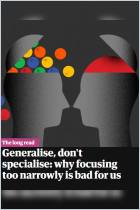加入 getAbstract 阅读摘要

加入 getAbstract 阅读摘要
David Brooks
You Might Be a Late Bloomer
The life secrets of those who flailed early but succeeded by old age
The Atlantic, 2024
看看什么内容?
What distinguishes those who succeed early from those who achieve greatness later in life? David Brooks investigates.
Recommendation
Modern society tends to glamorize the successes of those under age 30. Yet history shows that, in domains ranging from business to science to art, it’s often the late bloomer who achieves more enduring success. The average age of a person who makes a Nobel Prize–winning discovery, for example, is 44. In this insightful article, cultural commentator David Brooks explores notable examples of people who failed early but who, ultimately, made their mark on the world. He explains why late bloomers take longer to achieve their success, highlighting qualities that lead them to achieve great things.
Summary
About the Author
David Brooks is a political and cultural commentator who writes for The Atlantic and The New York Times. His most recent book is How to Know a Person.


























Comment on this summary